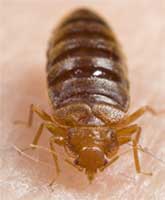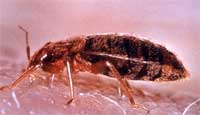  Adult
bedbugs are reddish brown, flattened, oval, and wingless, with microscopic
hairs that give them a banded appearance. A common misconception is
that they are not visible to the naked eye, but adults grow to 4 to
5 mm (one-eighth to three-sixteenths of an inch) in length and do
not move quickly enough to escape the notice of an attentive observer.
Newly hatched nymphs are translucent and lighter in color and continue
to become browner and molt as they reach maturity. When it comes to
size, they are often compared to lentils or appleseeds. Adult
bedbugs are reddish brown, flattened, oval, and wingless, with microscopic
hairs that give them a banded appearance. A common misconception is
that they are not visible to the naked eye, but adults grow to 4 to
5 mm (one-eighth to three-sixteenths of an inch) in length and do
not move quickly enough to escape the notice of an attentive observer.
Newly hatched nymphs are translucent and lighter in color and continue
to become browner and molt as they reach maturity. When it comes to
size, they are often compared to lentils or appleseeds.

Vampire bugs: Bedbugs are generally active only at night, with a peak attack period
about an hour before dawn, though given the opportunity, they may
attempt to feed at other times of day. Attracted by warmth and the
presence of carbon dioxide, the bug pierces the skin of its host
with two hollow tubes. With one tube it injects its saliva, which
contains anticoagulants and anesthetics, while with the other it
withdraws the blood of its host. After feeding for about five minutes,
the bug returns to its hiding place. The bites cannot usually be
felt until some minutes or hours later, as a dermatological reaction
to the injected agents. Although bedbugs can live for up to 18 months
without feeding, they typically seek blood every five to ten days.
 Not so dirty after all: Bedbugs are often erroneously associated with filth. They are attracted
by exhaled carbon dioxide, not by dirt, and they feed on blood,
not waste. In short, the cleanliness of their environments has no
effect on bedbugs. Their numbers may be reduced temporarily by vacuuming,
but will recover and require vacuuming again. Not so dirty after all: Bedbugs are often erroneously associated with filth. They are attracted
by exhaled carbon dioxide, not by dirt, and they feed on blood,
not waste. In short, the cleanliness of their environments has no
effect on bedbugs. Their numbers may be reduced temporarily by vacuuming,
but will recover and require vacuuming again.

Female bedbugs can lay up to five eggs in a day and 500 during a
lifetime. The eggs are visible to the naked eye measuring 1 mm in
length (approx. 2 grains of salt) and are a milky-white tone in
color.
A few bedbug species make use of a mating plug, secreted by the
male upon withdrawal after copulation, effectively gluing shut the
vaginal opening of the female against later males. Among such species,
the male impales the female via her abdomen, thus circumventing
a mating plug.
All text is available under the terms
of the GNU Free Documentation License
|